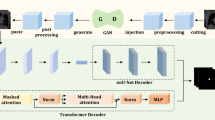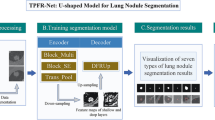Abstract
Purpose
Accurate quantification of pulmonary nodules helps physicians to accurately diagnose and treat lung cancer. We try to improve the segmentation efficiency of irregular nodules while maintaining the segmentation accuracy of simple types of nodules.
Methods
In this paper, we obtain the unique edge part of pulmonary nodules and process it as a single branch stream, i.e., border stream, to explicitly model the nodule edge information. We propose a multi-scale dense selective network based on border modeling (BorDenNet). Its overall framework consists of a dual-branch encoder–decoder, which achieves parallel processing of classical image stream and border stream. We design a dense attention module to facilitate a strongly coupled status of feature images to focus on key regions of pulmonary nodules. Then, during the process of model decoding, the multi-scale selective attention module is proposed to establish long-range correlation relationships between different scale features, which further achieves finer feature discrimination and spatial recovery. We introduce border context enhancement module to mutually fuse and enhance the edge-related voxel features contained in the image stream and border stream and finally achieve the accurate segmentation of pulmonary nodules.
Results
We evaluate the BorDenNet rigorously on the lung public dataset LIDC–IDRI. For the segmentation of the target nodules, the average Dice score is 92.78\(\%\), the average sensitivity is 91.37\(\%\), and the average Hausdorff distance is 3.06 mm. We further test on a private dataset from Shanxi Provincial People’s Hospital, which verifies the excellent generalization of BorDenNet. Our BorDenNet relatively improves the segmentation efficiency for multi-type nodules such as adherent pulmonary nodules and ground-glass pulmonary nodules.
Conclusion
Accurate segmentation of irregular pulmonary nodules can obtain important clinical parameters, which can be used as a guide for clinicians and improve clinical efficiency.






Similar content being viewed by others
References
Organization WH (2020) Latest global cancer data: cancer burden rises to 19.3 million new cases and 10.0 million cancer deaths in 2020. 2020-12-15)[2021-12-21]. https://www.iarc.who.int/news-events/latest-global-cancer-data-cancer-burden-rises-to-19-3-million-new-cases-and-10-0-million-cancer-deaths-in-2020
Blandin Knight S, Crosbie PA, Balata H, Chudziak J, Hussell T, Dive C (2017) Progress and prospects of early detection in lung cancer. Open Biol 7(9):170070
Bray F, Ferlay J, Soerjomataram I, Siegel RL, Torre LA, Jemal A (2018) Global cancer statistics 2018: Globocan estimates of incidence and mortality worldwide for 36 cancers in 185 countries. CA Cancer J Clin 68(6):394–424
Zhao J, Ji G, Qiang Y, Han X, Pei B, Shi Z (2015) A new method of detecting pulmonary nodules with pet/ct based on an improved watershed algorithm. PLoS ONE 10(4):0123694
Gould MK, Donington J, Lynch WR, Mazzone PJ, Midthun DE, Naidich DP, Wiener RS (2013) Evaluation of individuals with pulmonary nodules: When is it lung cancer?: diagnosis and management of lung cancer: American college of chest physicians evidence-based clinical practice guidelines. Chest 143(5):93–120
Hassani C, Varghese BA, Nieva J, Duddalwar V (2019) Radiomics in pulmonary lesion imaging. Am J Roentgenol 212(3):497–504
Keutgen XM, Hammel P, Choyke PL, Libutti SK, Jonasch E, Kebebew E (2016) Evaluation and management of pancreatic lesions in patients with von Hippel-lindau disease. Nat Rev Clin Oncol 13(9):537–549
Shi G, Wang J, Qiang Y, Yang X, Zhao J, Hao R, Yang W, Du Q, Kazihise NG-F (2020) Knowledge-guided synthetic medical image adversarial augmentation for ultrasonography thyroid nodule classification. Comput Methods Progr Biomed 196:105611
Zhao Z, Zhao J, Song K, Hussain A, Du Q, Dong Y, Liu J, Yang X (2020) Joint dbn and fuzzy c-means unsupervised deep clustering for lung cancer patient stratification. Eng Appl Artif Intell 91:103571
Wu Z, Zhou Q, Wang F (2021) Coarse-to-fine lung nodule segmentation in ct images with image enhancement and dual-branch network. IEEE Access 9:7255–7262
Pezzano G, Ripoll VR, Radeva P (2021) Cole-cnn: Context-learning convolutional neural network with adaptive loss function for lung nodule segmentation. Comput Methods Progr Biomed 198:105792
Perslev M, Dam E.B, Pai A, Igel C (2019) One network to segment them all: A general, lightweight system for accurate 3d medical image segmentation. In: International conference on medical image computing and computer-assisted intervention, pp 30–38 . Springer
Usman M, Lee B-D, Byon S-S, Kim S-H, Lee B-I, Shin Y-G (2020) Volumetric lung nodule segmentation using adaptive roi with multi-view residual learning. Sci Rep 10(1):1–15
Qin Y, Zheng H, Huang X, Yang J, Zhu Y-M (2019) Pulmonary nodule segmentation with ct sample synthesis using adversarial networks. Med Phys 46(3):1218–1229
Nishio M, Muramatsu C, Noguchi S, Nakai H, Fujimoto K, Sakamoto R, Fujita H (2020) Attribute-guided image generation of three-dimensional computed tomography images of lung nodules using a generative adversarial network. Comput Biol Med 126:104032
Sun Y, Tang J (2020) Lei: 3d segmentation of pulmonary nodules based on multi-view and semi-supervised. IEEE Access 8:26457–26467
Bianconi F, Fravolini ML, Pizzoli S, Palumbo I, Minestrini M, Rondini M, Nuvoli S, Spanu A, Palumbo B (2021) Comparative evaluation of conventional and deep learning methods for semi-automated segmentation of pulmonary nodules on ct. Quant Imag Med Surg 11(7):3286
Kalpathy-Cramer J, Zhao B, Goldgof D, Gu Y, Wang X, Yang H, Tan Y, Gillies R, Napel S (2016) A comparison of lung nodule segmentation algorithms: methods and results from a multi-institutional study. J Digit Imaging 29(4):476–487
Suji R.J, Godfrey W.W, Dhar J (2021) Comparing different deep learning backbones for segmentation of lung nodules. In: 2021 5th conference on information and communication technology (CICT), pp 1–5 . IEEE
Yufei Z, Zhizhong F, Jin X, Linghua M (2017) Image fusion algorithm based on gradient similarity filter. In: 2017 Asia-Pacific signal and information processing association annual summit and conference (APSIPA ASC), pp 287–291 . IEEE
Zhang J, Xie Y, Wang Y, Xia Y (2020) Inter-slice context residual learning for 3d medical image segmentation. IEEE Trans Med Imaging 40(2):661–672
Liu Y, Yu J, Han Y (2018) Understanding the effective receptive field in semantic image segmentation. Multimed Tools Appl 77(17):22159–22171
Armato SG III, McLennan G, Bidaut L, McNitt-Gray MF, Meyer CR, Reeves AP, Zhao B, Aberle DR, Henschke CI, Hoffman EA (2011) The lung image database consortium (lidc) and image database resource initiative (idri): a completed reference database of lung nodules on ct scans. Med Phys 38(2):915–931
Nagayama Y, Oda S, Nakaura T, Tsuji A, Urata J, Furusawa M, Utsunomiya D, Funama Y, Kidoh M, Yamashita Y (2018) Radiation dose reduction at pediatric ct: use of low tube voltage and iterative reconstruction. Radiographics 38(5):1421–1440
Çiçek Ö, Abdulkadir A, Lienkamp S.S, Brox T, Ronneberger O (2016) 3d u-net: learning dense volumetric segmentation from sparse annotation, pp 424–432. Springer
Milletari F, Navab N, Ahmadi S.-A (2016) V-net: Fully convolutional neural networks for volumetric medical image segmentation. In: 2016 Fourth international conference on 3D vision (3DV), pp 565–571
Zeng G, Zheng G (2019) 3d tiled convolution for effective segmentation of volumetric medical images. In: International conference on medical image computing and computer-assisted intervention, pp 146–154 . Springer
Wu W, Gao L, Duan H, Huang G, Ye X, Nie S (2020) Segmentation of pulmonary nodules in ct images based on 3d-unet combined with three-dimensional conditional random field optimization. Med Phys 47(9):4054–4063
Xiao Z, Liu B, Geng L (2020) Zhang: Segmentation of lung nodules using improved 3d-unet neural network. Symmetry 12(11):1787
Zhang J, Xia Y, Cui H, Zhang Y (2018) Pulmonary nodule detection in medical images: a survey. Biomed Signal Process Control 43:138–147
Acknowledgements
This work is supported by the National Natural Science Foundation of China [61872261,61972274].
Author information
Authors and Affiliations
Corresponding author
Ethics declarations
Conflict of interest
The authors have no conflict of interest.
Human and animal rights
This article does not contain any studies with human participants or animals.
Informed consent
Informed consent is obtained from all individual participants included in the study.
Additional information
Publisher's Note
Springer Nature remains neutral with regard to jurisdictional claims in published maps and institutional affiliations.
Rights and permissions
Springer Nature or its licensor (e.g. a society or other partner) holds exclusive rights to this article under a publishing agreement with the author(s) or other rightsholder(s); author self-archiving of the accepted manuscript version of this article is solely governed by the terms of such publishing agreement and applicable law.
About this article
Cite this article
Wang, H., Xiao, N., Luo, S. et al. Multi-scale dense selective network based on border modeling for lung nodule segmentation. Int J CARS 18, 845–853 (2023). https://doi.org/10.1007/s11548-022-02817-7
Received:
Accepted:
Published:
Issue Date:
DOI: https://doi.org/10.1007/s11548-022-02817-7




